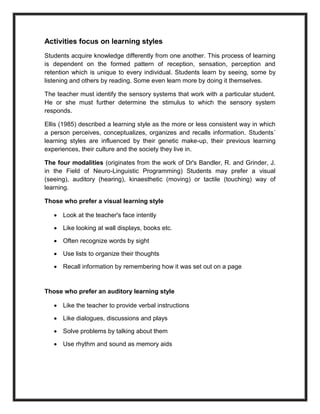
Activities focus on learning styles
- 1. Activities focus on learning styles Students acquire knowledge differently from one another. This process of learning is dependent on the formed pattern of reception, sensation, perception and retention which is unique to every individual. Students learn by seeing, some by listening and others by reading. Some even learn more by doing it themselves. The teacher must identify the sensory systems that work with a particular student. He or she must further determine the stimulus to which the sensory system responds. Ellis (1985) described a learning style as the more or less consistent way in which a person perceives, conceptualizes, organizes and recalls information. Students´ learning styles are influenced by their genetic make-up, their previous learning experiences, their culture and the society they live in. The four modalities (originates from the work of Dr's Bandler, R. and Grinder, J. in the Field of Neuro-Linguistic Programming) Students may prefer a visual (seeing), auditory (hearing), kinaesthetic (moving) or tactile (touching) way of learning. Those who prefer a visual learning style Look at the teacher's face intently Like looking at wall displays, books etc. Often recognize words by sight Use lists to organize their thoughts Recall information by remembering how it was set out on a page Those who prefer an auditory learning style Like the teacher to provide verbal instructions Like dialogues, discussions and plays Solve problems by talking about them Use rhythm and sound as memory aids
- 2. Those who prefer a kinesthetic learning style Learn best when they are involved or active Find it difficult to sit still for long periods Use movement as a memory aid Those who prefer a tactile way of learning Use writing and drawing as memory aids Learn well in hands-on activities like projects and demonstrations Activities about the Four Modalities Visual Use many visuals in the classroom. For example, wall displays posters, realia, flash cards, graphic organizers etc. Auditory Use audio tapes and videos, storytelling, songs, jazz chants, memorization and drills. Allow learners to work in pairs and small groups regularly. Kinesthetic Use physical activities, competitions, board games, role plays etc. Intersperse activities which require students to sit quietly with activities that allow them to move around and be active. Tactile Use board and card games, demonstrations, projects, role plays etc. Use while-listening and reading activities. For example, ask students to fill in a table while listening to a talk, or to label a diagram while reading.
- 3. In the language teaching field, some of the differences among students have been attributed to students having different learning styles. For instance, some students are better visual learners than aural learners. Gardner has theorized that individuals have at least seven distinct intelligences that can be developed over a lifetime. The seven are; Logical/Mathematical – The ability to use numbers effectively, to see abstract pattern, and to reason well. Visual/Spatial – The ability to orient oneself in the environment, to create mental images, and sensitivity to shape, size, color. Body/Kinesthetic – The ability to use one´s body to express oneself and to solve problems. Musical/ Rhythmic – An ability to recognize tonal patterns and a sensitivity to rhythm, pitch, melody. Interpersonal – The ability to understand another person´s, moods, feeling, motivations, and intentions. Intrapersonal – The ability to understand oneself and to practice self-discipline. Verbal/Linguistic – The ability to use language affectively and creatively. Activities for Multiple Intelligences Logical/Mathematical Puzzles Games Logical Sequential Presentations Classifications and Categorizations Visual/Spatial Charts Grids Videos Drawing
- 4. Body/Kinesthetic Hands-on activities Field trips Pantomime Musical/ Rhythmic Singing Playing music Jazz chants Interpersonal Pairwork Project work Group problem solving Intrapersonal Self-evaluation Journal keeping Options for homework Verbal/Linguistic Note-taking Story telling Debats Gardner (1999) added an eighth intelligence, one he calls “The naturalist” Naturalist – Someone knowledge about and comfortable in the natural world.
- 5. References http://www.teachingenglish.org.uk/think/methodology/learning_style.shtml Larsen-Freeman Diane (2000) .Techniques and Principles in Language Teaching. 2nd edition. University of Oxford.